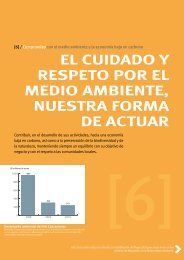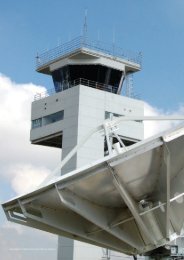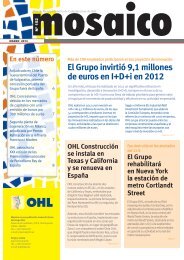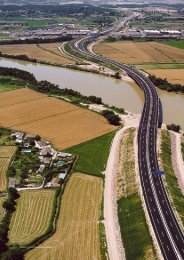Nº 84, Septiembre/September 2012 - Ohl
Nº 84, Septiembre/September 2012 - Ohl
Nº 84, Septiembre/September 2012 - Ohl
Create successful ePaper yourself
Turn your PDF publications into a flip-book with our unique Google optimized e-Paper software.
46<br />
Viento<br />
La acción de un viento en dirección paralelo a la orilla solicita<br />
horizontalmente al puente que funciona como una<br />
ménsula de 40 m de luz, siendo esta función de la superficie<br />
expuesta al viento tanto de la parte emergente de la<br />
plataforma flotante, como de la perfilería del puente, sobre<br />
la cual actúa con un valor característico de 50 kg/m 2 . Los<br />
vientos en dirección perpendicular a la orilla arrojaron resultados<br />
despreciables.<br />
Oleaje<br />
Al igual que el viento, también el oleaje en la dirección paralela<br />
a la orilla solicita horizontalmente al puente, pero<br />
esta vez es función de la superficie sumergida expuesta a<br />
la ola.<br />
Además también surge otro efecto, y no menos despreciable,<br />
consecuencia de la oscilación vertical que sufre la<br />
plataforma flotante al paso de las olas (cabeceo de la plataforma)<br />
y que solicita la torsión a la pasarela cíclicamente,<br />
siendo esto función de la altura de ola significante (H0 =<br />
0,50 m en el embalse Mequinenza), de la longitud de onda<br />
(Lw = 15,20 m en el embalse Mequinenza) y de las dimensiones<br />
de la plataforma flotante. Esto nos lleva a cuantificar<br />
una oscilación para la plataforma flotante del 6%, sin considerar<br />
la rigidez que aporta la plataforma, lo cual se traduce<br />
en un par de fuerzas verticales de signo contrario de valor<br />
14.000 kg en cada pasador entre la pasarela y plataforma<br />
flotante.<br />
Wind<br />
Detalle de rótula unidireccional.<br />
Uni-directional hinge detail.<br />
The action of the wind parallel to the shore applies horizontal<br />
stress on the bridge, which acts like a cantilever<br />
with a span of 40 m. This stress is a function of the surface<br />
area exposed to the wind of both the above-water part<br />
of the floating platform and the bridge profiles, with a<br />
characteristic value of 50 kg/m 2 acting on it. The effects<br />
of the winds perpendicular to the shore were negligible.<br />
Waves<br />
As with the wind, wave action horizontal to the shore<br />
applies horizontal stress to the bridge, but in this case,<br />
it is a function of the submerged surface area that is<br />
exposed to the wave.<br />
There is also another equally-significant effect, which is<br />
the effect of the vertical oscillation of the floating platform<br />
when the waves pass (bobbing of the platform) and<br />
which applies cyclical torsional stress to the walkway.<br />
This is a function of the significant wave height (H0 =<br />
0.50 m in the Mequinenza reservoir), the wavelength (Lw<br />
= 15.20 m in the Mequinenza reservoir) and the dimensions<br />
of the floating platform. Based on this, the oscillation<br />
of the floating platform was quantified at 6%,<br />
without taking into account the stiffness contributed by<br />
the platform, which translates into a negative vertical torque<br />
value of 14,000 kg on each pin between the walkway<br />
and the floating platform.
















